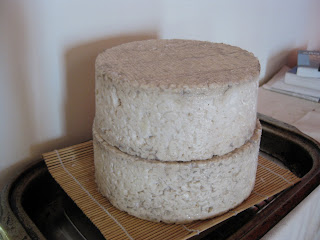
Here is an update of the blue goat cheese I made a few weeks ago. The picture above shows the salting procedure. The recipe asked for a cheese to be salted on top and stacked with another cheese. This should have been done in a cooler environment, but conditions required in the recipes are not always available to the home cheese maker. So a look for the most practical solution and being aware that the conditions are not always optimum.
In the photograph below, the cheeses have just been moved to the aging refrigerator and the last picture shows the bottom cheese after having been in the fridge for a week.
In the last post I wrote about moving the cheeses upstate to a cooler environment. I did not move the blue cheese, nor the lactic cheeses. Because I age these cheese in refrigerators, I can keep them here in Brooklyn. When I first made a blue cheese, I put it in the cave with the other cheeses and after a few days, all the cheese started to grow blue molds. I did some research and asked a experienced cheese maker about this phenomena. He said that once blue mold was introduced in a cave, it will contaminate everything else. His reply was supported by what I read in other sources. But when I on a visit recently at a large new aging facility in Vermont, I saw blue cheeses aging in a cave among many other different types of cheeses. When I asked about cross contamination, they said that it wasn't a problem. Sometime a bloomy rind cheese might shows some spots of blue mold but this could have resulted from contaminated hands according to my guide.
Well, I am thrown again. Perhaps because the circumstances and conditions are so different in many cases, there might not be just one answer. For now though, I will keep my blue cheeses here in the refrigerators in Brooklyn. This gives me at least some cheeses to pamper on a daily bases.



No comments:
Post a Comment